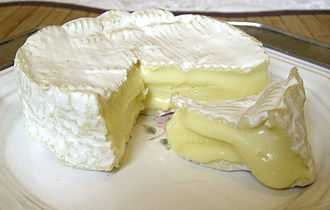Camembert





Camembert is a soft, creamy, surface-ripened cow's milk cheese that originated in the late 18th century in Normandy, France. It is named after the village of Camembert, where it was first created. Camembert is one of the most famous French cheeses and is known for its delicate, earthy flavor and creamy texture.
History[edit]
The creation of Camembert cheese is attributed to Marie Harel, a farmer from Normandy, who is said to have invented it in 1791 with the advice of a priest from Brie, thus linking Camembert to the long tradition of French cheese-making. The cheese quickly gained popularity, and its production spread throughout Normandy. By the 19th century, Camembert had become a staple of French cuisine and began to be exported internationally.
Production[edit]
Camembert is made from unpasteurized cow's milk, although many modern versions use pasteurized milk to meet health standards of various countries. The milk is coagulated with rennet, and the resulting curd is cut, stirred, and heated slightly before being transferred to molds. The cheese is then salted and left to ripen for at least three weeks. During this time, it is covered with a white mold, Penicillium camemberti, which gives Camembert its characteristic rind and contributes to its flavor profile.
Characteristics[edit]
A typical Camembert cheese is round, about 250 grams in weight, and has a fat content of at least 45%. Its rind is bloomy and edible, covered in a white mold. The interior of the cheese is soft, creamy, and pale yellow in color, with a slightly runny texture at room temperature. Camembert has a rich, buttery flavor with hints of mushrooms and earthy undertones.
Serving and Consumption[edit]
Camembert is often served at room temperature to enhance its flavor and texture. It can be spread on bread or crackers and is commonly paired with fruits such as apples or pears, nuts, and a variety of wines, particularly reds from Bordeaux or whites from the Loire Valley. Camembert is also a popular ingredient in various culinary dishes, including baked Camembert and Camembert in puff pastry.
Cultural Significance[edit]
Camembert holds a significant place in French culture and cuisine. It is often associated with the concept of terroir, the set of all environmental factors that affect a crop's phenotype, including unique environment contexts, farming practices, and a crop's specific growth habitat. The cheese has also been the subject of various artistic and literary works, symbolizing French heritage and gastronomy.
Regulation[edit]
In France, the name "Camembert de Normandie" is protected by an Appellation d'Origine Contrôlée (AOC), ensuring that only cheese produced using traditional methods and within the designated geographic area can be sold under this name. This designation aims to preserve the authenticity and quality of Camembert.
See Also[edit]
Ad. Transform your life with W8MD's Budget GLP-1 injections from $75


W8MD offers a medical weight loss program to lose weight in Philadelphia. Our physician-supervised medical weight loss provides:
- Weight loss injections in NYC (generic and brand names):
- Zepbound / Mounjaro, Wegovy / Ozempic, Saxenda
- Most insurances accepted or discounted self-pay rates. We will obtain insurance prior authorizations if needed.
- Generic GLP1 weight loss injections from $75 for the starting dose.
- Also offer prescription weight loss medications including Phentermine, Qsymia, Diethylpropion, Contrave etc.
NYC weight loss doctor appointmentsNYC weight loss doctor appointments
Start your NYC weight loss journey today at our NYC medical weight loss and Philadelphia medical weight loss clinics.
- Call 718-946-5500 to lose weight in NYC or for medical weight loss in Philadelphia 215-676-2334.
- Tags:NYC medical weight loss, Philadelphia lose weight Zepbound NYC, Budget GLP1 weight loss injections, Wegovy Philadelphia, Wegovy NYC, Philadelphia medical weight loss, Brookly weight loss and Wegovy NYC
|
WikiMD's Wellness Encyclopedia |
| Let Food Be Thy Medicine Medicine Thy Food - Hippocrates |
Medical Disclaimer: WikiMD is not a substitute for professional medical advice. The information on WikiMD is provided as an information resource only, may be incorrect, outdated or misleading, and is not to be used or relied on for any diagnostic or treatment purposes. Please consult your health care provider before making any healthcare decisions or for guidance about a specific medical condition. WikiMD expressly disclaims responsibility, and shall have no liability, for any damages, loss, injury, or liability whatsoever suffered as a result of your reliance on the information contained in this site. By visiting this site you agree to the foregoing terms and conditions, which may from time to time be changed or supplemented by WikiMD. If you do not agree to the foregoing terms and conditions, you should not enter or use this site. See full disclaimer.
Credits:Most images are courtesy of Wikimedia commons, and templates, categories Wikipedia, licensed under CC BY SA or similar.
Translate this page: - East Asian
中文,
日本,
한국어,
South Asian
हिन्दी,
தமிழ்,
తెలుగు,
Urdu,
ಕನ್ನಡ,
Southeast Asian
Indonesian,
Vietnamese,
Thai,
မြန်မာဘာသာ,
বাংলা
European
español,
Deutsch,
français,
Greek,
português do Brasil,
polski,
română,
русский,
Nederlands,
norsk,
svenska,
suomi,
Italian
Middle Eastern & African
عربى,
Turkish,
Persian,
Hebrew,
Afrikaans,
isiZulu,
Kiswahili,
Other
Bulgarian,
Hungarian,
Czech,
Swedish,
മലയാളം,
मराठी,
ਪੰਜਾਬੀ,
ગુજરાતી,
Portuguese,
Ukrainian
